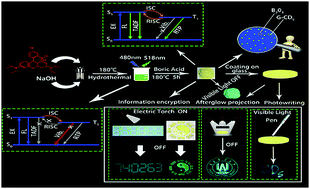A visible-light-excited afterglow achieved by carbon dots from rhodamine B fixed in boron oxide†
Abstract
Visible light as an excitation source has less phototoxicity toward health, and more accessibility for practical applications as compared to ultraviolet light does. However, obtaining visible-light-excited afterglow materials based on carbon dots is a formidable challenge as such materials have not emerged thus far. Herein, visible-light-excited thermally-activated delayed fluorescence combined with phosphorescence were achieved by embedding green emissive carbon dots (G-CDs) with an ultra-high quantum yield in the matrix of boron oxide. G-CDs were synthesized via the hydrothermal pyrolysis of rhodamine B in the aqueous solution of NaOH. The ultra-long afterglow can last for 13 s after the removal of the excitation source (UV or visible light). The afterglow lifetime of the G-CD/B2O3 composite at the emission wavelength of 480 nm is 477.96 ms at room temperature, and 805.94 ms at 273 K. Given these features, information security, afterglow projection and photo writing were successfully realized in the G-CD/B2O3 composite-based materials using a cellphone or electric torch light as a light source.



 Please wait while we load your content...
Please wait while we load your content...